Calendar effects, base effects, and holidays continued to plague retail sales estimates. Where February 2016 included a 29th day of extra selling/buying, March finds an early Easter holiday relative to last year (it was in April). The result is difficult comparisons where the unadjusted series is not measuring underlying consumer growth but these other factors. That should change, however, in April which suggests that there is a reckoning due for next month for the unadjusted data.
A good example of this statistical unevenness is the auto segment. Auto sales (unadjusted) were barely positive in January at +1.6%, blasted ahead in February +12%, and now have come back down below average to just 4.4%. The cumulative change for the first quarter is 5.8% which is significantly less than the 7.3% average over the last six months of 2015. Despite the volatility month to month, the overall muted trend seems to confirm the growing inventory of motor vehicles.
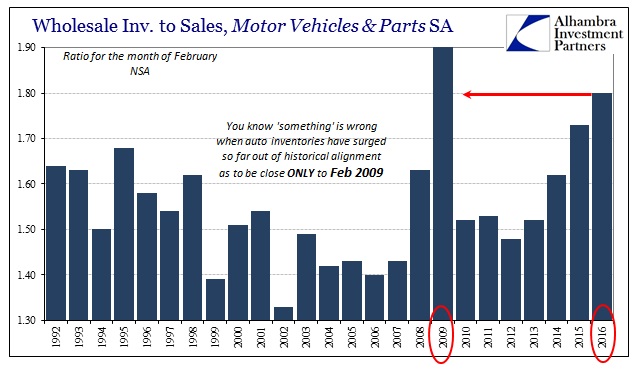
Overall, retail sales growth fell back in March from the calendar effects of February, suggesting that an early Easter is not so much of a boost as an extra day. Total retail sales were a very concerning +0.93% in January, literally unbelievable +6.90% (revised upward, no less) in February, and now +3.64% for March. The progression was similar ex autos: +0.79%, +5.70% and +3.42%.

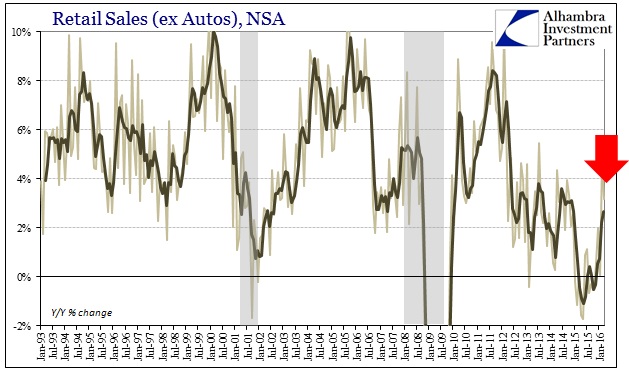
Even with whatever non-economic boost for February and March, the 6-month average remains right at the 3% level that is usually associated with recession. It first dropped below 3% last April, meaning that it has been 12 months or a full year of very weak retail sales. That is, however, the best case as the seasonally-adjusted series that attempts to account for calendars and holidays presents a much less optimistic take (which, for once, I have to agree with). The year-over-year growth in adjusted retail sales (ex autos) is just 2.7% for February and 1.8% in March.
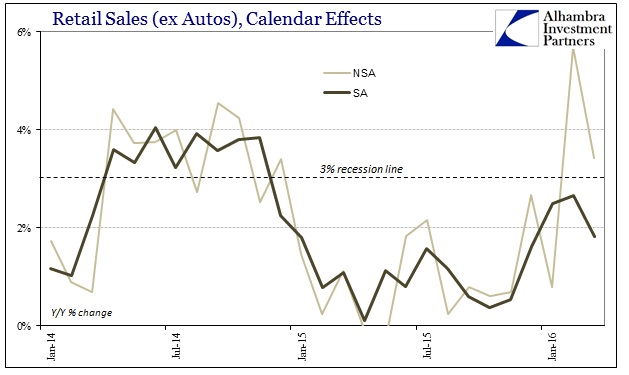
The 6-month average in the adjusted series is only 1.6% compared to 2.31% unadjusted. In many ways, however, trying to figure out the difference in adjustments still misses the point, as in the end they aren’t really as different as they might at first appear. As with everything else in this ongoing and downshifting slowdown, what seems to be the most pressing problem are these slumps to begin with. They look like recessions only in miniature, but in reality the biggest economic problem is that they represent/create durable or even permanent alterations in the trajectory.

The Great Recession, particularly the second half, is unmistakable as a recession (above). During the “recovery” thereafter there are three significant deviations that each look like their own further recession but much shallower and of shorter duration. The first was in the middle of 2010 coincident to the flash crash and European concerns over Greece (which wasn’t about Greece but wholesale finance and collateral). The recovery trend was not altered by that first detour; it was, however, by the second that appeared in March 2012 (following the events of 2011). After that second mini-recession, the trend changed even slower, as the Recover(ish) phase downshifted into the full expression of what had been called the “New Normal.”
That slower growth after the middle of 2012 only kept up economic pressure as it meant that the recovery itself became an even more remote possibility since the first stage of the recovery wasn’t nearly enough to close the gap. In late 2014, December in the retail sales data, another mini-recession struck (coincident to the oil/commodity crash and the first instance of junk bond abhorrence) which has had the same effect as that of the 2012 version. The growth rate depressed yet again afterward both suggesting (if not proving) that the full and actual recovery will never show up and leaving the trajectory in retail sales now as almost flat. It is the increasing slowdown that seems to have recreated the GR recession cycles a further two additional occasions in smaller versions (exhibiting fractal behavior).
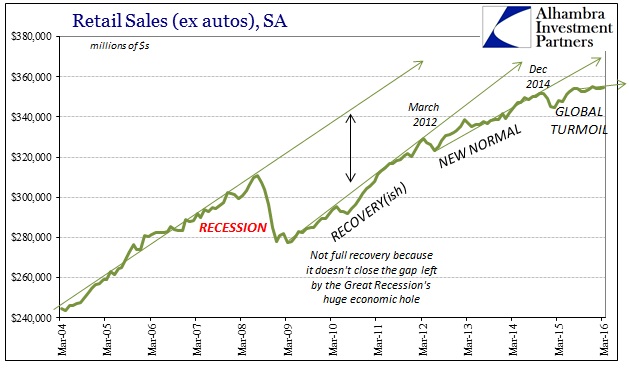
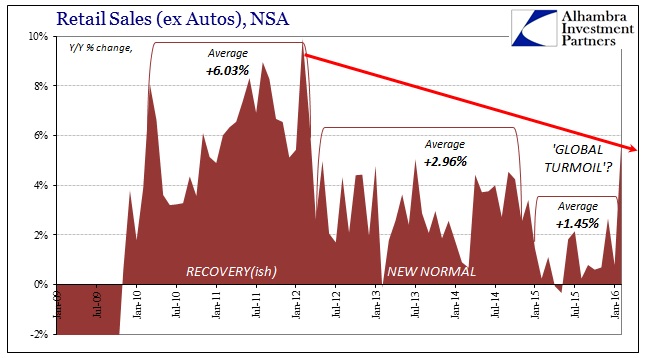
Each recession or mini-recession opens a wider gulf that the reduced growth rate after it cannot possibly close. The net effect over time is attrition and imbalance; the latter most obvious in accumulated inventory especially since the inflection in late 2014. As I have written before, it isn’t necessarily recession but that actually makes it much worse. An actual recession cycle no matter how severe at least comes with a rather quick expiration and leaves us little doubt as to what to expect on the recovery side of it. This repeating “cycle” of an ongoing slowdown only getting worse is entirely open ended. As I wrote yesterday in the global review of this slowdown:
This is not an insignificant difference; at the end of secular stagnation is downgraded growth, but steady growth nonetheless. The final stage of a slowdown based on monetary decay and restriction is likely to be nothing like that.
That is the interpretation of retail sales in whatever form and effect for February and March. Volatility in the data suggests maybe not yet full-blown recession but undoubtedly still within the post-December 2014 slowdown phase (what I have classified as “global turmoil” as clearly distinct from the “new normal” trend). And, as always, the continuation of the slowdown does not preclude the onset of full recession, a possibility that actually rises as the difference between the downward trajectory of sales (across the whole supply chain) and inventory (especially now autos) continues. I think this is the only way to account for almost two years now of recession-like economic existence and yet no discernable reversion that a “normal” recession would have produced long before now.
What we are seeing here and in the “manufacturing recession” is the revealing economic trend or potential baseline while still awaiting whatever inevitable cycle.
